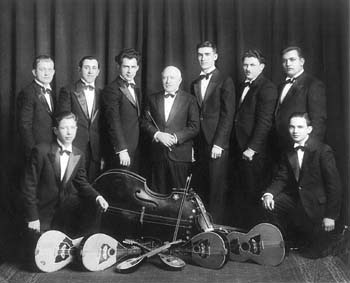 |

presents Nebraska’s Orchestra “Soko”
November/December 1999, vol. XVI, no. 2 |
 |

presents Nebraska’s Orchestra “Soko”
November/December 1999, vol. XVI, no. 2 |
|
|
Only a few days and hours separate us from
the beginning of the 21st century, and in looking back, we are reminded
of tamburitza'ssuccess over the past one hundred years and wonder
how it will fare in the new millennium.
From the Serbian kafanasof Europe,
tamburitzamade
a huge leap across “the pond”—the Atlantic Ocean—and came to America with
our people who brought with them their religion, their customs, and—most
important to this subject—the music of the tambura.
Much personal joy comes from the fact that
the early musicians were afforded the opportunity to make records which,
in turn, guaranteed the preservation of old songs and the melodic sound
of the tamburitzas. The Sremska tamburais a national
treasure in Serbia, and it didn’t take long for it to find a new home here
in America.
With that in mind and with great pleasure,
I write my last column of the 20th century featuring the 1927 Soko Orchestraof
Omaha, Nebraska.
From the ranks of an athletic and character-building
organization in Omaha called Sokoli, there emerged a group of talented
young men—Pete Markovich, Eli Drakulich, Nick Plecas, Mike Churchich, Tom
Zoroya, Milan (Mike) Zemunski, Joe Churchich, Mike (Mac) Medakovich—who,
through perseverance and hard work, gave birth to an excellent tamburitzaensemble.
The orchestra’s first teacher was George Kachar,
who can best be described as a driving force in the establishment of tamburitzahere
in America. As Mr. Kachar moved from city to city spreading the "tambura
gospel,” his work in Omaha eventually fell to Frank L. Buckingham who taught
music at the University of Omaha.
An avowed stringed-music enthusiast, Professor
Buckingham, at the age of just sixteen, had been a featured banjoist with
World Boxing Champion John L. Sullivan’s touring road show. His knowledge
and insight not only taught the young men the music of their heritage,
but also included complicated marches and classical favorites of the wider
American public. Professor Buckingham taught the Soko Orchestrafrom
1927 to 1929.
The orchestra began traveling and performed
in cities like Council Bluffs and Des Moines, Iowa, and made successful
trips to St. Louis, Missouri, where their musicianship inspired St. Louis
to found their own tamburitzagroup. During the early 1930’s, Sokoplayed
at the Serbian monastery in Libertyville and broadened their tour to St.
Paul, Minnesota, and then to the Iron Range. Those days, with vaudeville
in full swing, the orchestra was approached by the RKO vaudeville circuit,
but a combination of fate and the Great Depression and responsibilities
at home prevented the tamburasifrom taking on the venture.
At its peak, the orchestra played on radio
station WOW, where T.V. star Johnny Carson got his start. Iowa’s Shenandoah
radio station was their next conquest, and their schedule grew and grew.
As a point of interest, the Popovich Brothers’ Orchestra, when on tour
in 1928, played at the home of the Zemunski family before leaving for St.
Louis and then Chicago, where they would eventually make their home.
The personnel of the Sokosproved to
be a very worthy and enterprising group. Pete Markovich, lead bracplayer,
would later move to Milwaukee, Wisconsin, where he owned and operated the
Balkan Inn. His orchestra entertained there on weekends, and, ironically,
Pete Markovich died while playing his beloved bracat the Balkan
Inn.
Eli Drakulich, who played the tamburitza
berda, settled in Arizona following his hitch in World War II. He ran
a successful heavy equipment operation.
A short-term orchestra member was Nick Plecas,
who left to become a doctor. During World War II, he served as a colonel
in the army.
Mike Churchich, the primas, was an
outstanding athlete. He went on to play semi-pro football.
Tom Zoroya, also a primaplayer, was
part of the contingent of American students who studied at the University
of Belgrade in the 1930’s. He later worked in a U.S. Postal Unit.
Joe Churchich, the celloplayer in the
orchestra, did the arranging for Soko. He would later become head
of the city parks and recreational centers. A park in Omaha was later named
for him.
Milan (Mike) Zemunski played second bugarija.
He immigrated to America from Banat at the age of twelve. In addition to
being Soko’sexcellent vocalist, he served as instructor for the
group. He was a meat wholesaler for northeastern Nebraska, and, after World
War II, he expanded his business to include northwest Iowa.
Mike (Mac) Medakovich was also a bugarijaplayer.
He was very successful in the business world as the owner and operator
of the Cary-McKenzie Printing Co.
A later enlistee to the orchestra was a fine
violinist, known only as Tony. Unofficially, it is said that he committed
suicide after the theft of his priceless violin.
Whether performing on their Chicago-made Groeschl
tamburitzasor
following their chosen professions, the members of
Soko Orchestrawere
a shining example of Serbian talent and the will to succeed.
For me, remembering this fine orchestra—and
this century’s great tamburatradition in America—seems like a wonderful
way to prepare for the new millennium.
All rights reserved. No part of this publication may be reproduced without the express written permission of SERB WORLD U.S.A. Copyright 1999 by SERB WORLD U.S.A.
|
Sample Articles |
a Subscription |
Back Issue Titles |
Back Issues |